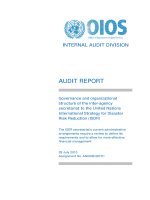Week 7 international strategy
Bạn đang xem bản rút gọn của tài liệu. Xem và tải ngay bản đầy đủ của tài liệu tại đây (385.79 KB, 26 trang )
3BM020: Organisational Strategy
and Decision Making
Lecture: Week 7
Learning outcomes
Assess
the internationalisation
potential of different markets,
sensitive to variations over time
Identify sources of competitive
advantage in international strategy
Distinguish between four main types
of international strategy
Rank markets for entry or expansion,
taking into account attractiveness,
cultural, and other forms of distance
and competitor retaliation threats
In the news –This time last year
In the news Oct - 2016
Apple iPhone sales fall, but beat estimates
Apple has reported its third quarter
in a row of falling iPhone sales and
revenue, but sales beat analyst
expectations.
The tech giant sold 45.51 million
iPhones in the three months to 24
September, beating an average
estimate of 44.8 million.
The company also forecast higherthan-expected holiday season
revenue of between $76bn and
$78bn.
But revenue in the fourth quarter fell
9% to $46.85bn.
That meant annual revenue fell for
the first time since 2001, highlighting
a slowdown in the smartphone
market as well as intensifying
competition, particularly from
In the news Oct - 2016
Apple raises computer prices in UK
One analyst said consumers
should expect further price
increases.
"Apple has to recalibrate prices
after significant currency
fluctuations, and since the EU
referendum, UK prices are out of
sync with the dollar," said Patrick
O'Brien, analyst at the Verdict
Retail consultancy.
"Apple has taken the hit up until
now. While price increases won't
look good to the consumer, it's
difficult to blame Apple.
"Once you strip out UK sales tax
(VAT) and the currency
conversion, the new UK prices
could still be viewed as fair."
Stimuli to Internationalise
In business activities, a variety of stimuli push and
pull firms along the international path.
The major motivations for firms to go international
have been differentiated into proactive and reactive.
Proactive motivations represent stimuli to attempt
strategic change.
Reactive motivations influence firms that respond to
environmental shifts by changing their activities over
time.
Proactive firms internationalise because they want
to…reactive firms internationalise because they
have to.
Strategy Framework
Internationalisation
drivers
Sources of
competitive advantage
International
strategy
Market
selection
Mode of entry
8-7
Drivers of Internationalisation
Market drivers
•
•
•
Similar customer needs
Global customers
Transferable marketing
Government drivers
•
•
•
Cost drivers
Trade policies
Technical standards
Host government policies
International
strategies
•
•
•
Scale economies
Country-specific
differences
Favourable logistics
Competitive drivers
•
•
Interdependence between
countries
Competitors’ global strategies
8-8
Why firms internationalise
PROACTIVE Motivators
Profit
Unique products
Technological advantages
Exclusive information
Managerial urge
Tax Benefit
Economies of scale
•
•
•
•
•
•
REACTIVE Motivators
Competitive pressures
Overproduction
Declining domestic
sales
Excess capacity
Saturated domestic
markets
Proximity to customers
and ports
Change agents in the
internationalisation process
Internal
Enlightened
management
New management
Significant internal event
External
Foreign demand
Competition
Domestic distributors
Service firms
Business associations
Governmental activities
Export intermediaries Export management
companies and Trading
companies
Porter’s Diamond
Porter’s
Diamond suggests
that there are inherent
reasons why some nations are
more competitive than others,
and why some industries
within nations are more
competitive than others.
Porter’s Diamond
Firm strategy,
structure
and rivalry
Factor
conditions
Demand
conditions
Related and
supporting
industries
8-12
Global sourcing
Global
sourcing refers
to purchasing services
and components from
the most appropriate
suppliers around the
world regardless of their
location.
Locational Advantages
of Global Sourcing
Cost advantages
Unique capabilities
National characteristics
8-14
Global R&D Network
8-15
Market Characteristics and the
PESTEL Framework
Political
Economic
Social
Legal
8-16
The CAGE Framework
Cultural
distance
Geographic
distance
Administrative and
political distance
Economic/ wealth
distance
8-17
Exporting
Advantages
No need for
operational facilities
in host country
Economies of scale
Internet facilitates
exporting
opportunities
Disadvantages
Lost location
advantages
Dependence on
export
intermediaries
Exposure to trade
barriers
Transportation costs
8-18
Joint Ventures and Alliances
Advantages
Shared investment
risk
Complementary
resources
May be required for
market entry
Disadvantages
Difficult to find good
partner
Relationship
management
Loss of competitive
advantage
Difficult to integrate
and coordinate
8-19
Licensing
Advantages
Contractual
source of income
Limited economic
and financial
exposure
Disadvantages
Difficult to identify
good partner
Loss of
competitive
advantage
Limited benefits
from host nation
8-20
Foreign Direct Investment
Advantages
Full control
Integration and
coordination
possible
Rapid market entry
through acquisitions
Greenfield
investments
Disadvantages
Substantial
investment and
commitment
Acquisitions may
create integration/
coordination issues
Greenfield
investments are
time consuming and
unpredictable
8-21
Foreign market entry, risk, resources &
control
High
Amount of
resources
required
Risk
Resourc
es
Foreign
Direct
Investment
Strategic alliance
Exporting
Low
Low
High
Control
Summary (1)
Internationalisation potential in any
particular market is determined by four
drivers: market, cost, government, and
competitors’ strategies.
Sources of advantage can come from global
sourcing through the international value
network and national sources of advantage
The main types of international strategy
vary according to extent of coordination and
geographical configuration: simple export,
complex export, multidomestic, and global
8-24
Summary (2)
Market selection for international
entry should be based on
attractiveness, multidimensional
measures of distance and
expectations of competitor retaliation
Modes of entry into new markets
include export, licensing, joint
ventures, and foreign direct
investment
8-25
Key questions: Global, Local, or Regional?
Which products and services are
becoming more ‘global’ over time?
Which products and services are
becoming less ‘global’?
Does this understanding impact upon
your organisation?
Which national sources of competitive
advantage, if any, might your
organisation draw from its national base?
8-26









